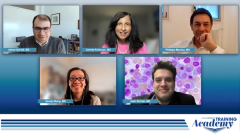
Multiple Myeloma: Selecting Among the BCMA-Targeting Therapies
Shared insight on how experts select among the available BCMA-targeting bispecific antibodies and CAR T-cell therapies in patients with multiple myeloma.
Episodes in this series

Transcript:
Amrita Krishnan, MD: If it wasn’t complicated enough, let’s make it more complicated in regard to sequential BCMA-targeted bispecific therapies. Al [Garfall] spoke about point mutations. Maybe 1 doesn’t work. Would another 1 work?
Joshua Richter, MD: Part of the progression beyond some of these agents isn’t strictly related to antigen loss. A lot of this is probably related to T-cell exhaustion and the health of the T cells. My thinking is that they’re probably similar to IMIDs [immunomodulatory imide drugs]. If you were on Revlimid for 5 years and you progress, I’m more likely to use pomalidomide than in someone who progressed within a few months of Revlimid. Then it might be time to go to a different target. If you get a BCMA agent and you progress rapidly, would I jump to another 1? Maybe a little less so, but there’s so much more that we don’t know than what we do know about this area.
Amrita Krishnan, MD: To stay on our last question about BCMA, which is the 1 we’re wrestling with right now is, we’re choosing between a BCMA-directed bispecific and a CAR [chimeric antigen receptor] T cell. It’s individualized, and there’s some patient preference and access. But if all things were generally equal in terms of accessibility, how would you see that? Philippe, what’s the European opinion?
Philippe Moreau, MD: That’s a key question: how to sequence when we are using agents targeting BCMA. In the MajesTEC-1 study, a small group of patients were previously exposed to BCMA agents. With teclistamab, the response rate was about 50%. That means that although few of them receive CAR T cells first, patients were rescued when we did CAR T first targeting BCMA and subsequently at the time of the progression. One or 2 years later, you can rescue with teclistamab. The opposite probably isn’t true. We have some data published by Adam Cohen in Blood last September. He showed that when patients were previously with bispecific antibodies, you couldn’t rescue them easily with CAR T. The response rate was lower, and the PFS [progression-free survival] was very short. The optimal sequence is probably CAR T, then bispecifics at the time of the progression. I won’t use bispecifics first and CAR T subsequently. But we have few data. We need more data.
Sandy Wong, MD: That’s a good point. For the CARTITUDE-2 study, cohort C was presented at IMS [International Myeloma Society Annual Meeting] last August. These are patients who’ve had a prior BCMA-targeted agent and then they went on cilta cel [ciltacabtagene autoleucel]. If you look at the inclusion-exclusion criteria, these patients are in the late-line setting. You would expect cilta cel [ciltacabtagene autoleucel] to have an overall response rate of over 90% based on the registration of the CARTITUDE-1 study. But you see the response rate drops to around 50%. That’s a large drop compared with the small number of patients from the MajesTEC-1 study…. Those are small numbers. Looking at using BCMA-targeted agents prior to T-cell engagers, the drop in terms of overall responses was 10% as opposed to the larger drop that you see. It’s hard to choose. I agree. The sequencing is important in this situation.
We saw the real-world data from the US [Lymphoma] CAR T Consortium, where they looked at patients treated with ide cel [idecabtagene autoleucel] in the real-world setting. The farther you’re away from a prior BCMA-targeted treatment, the better the response. We’re still trying to work out the optimal sequence. If you were to go back in with another BCMA-targeted agent, how much time should elapse, especially you have a BCMA-targeted CAR T after a BCMA-targeted T-cell engager. What’s the optimal duration of time in terms of spacing? A lot of that needs to be worked out.
Amrita Krishnan, MD: When we hear from Al [Garfall] and Josh about non-BCMA targeted bispecifics, that will be interesting because the question will be, do you use those first? You want to use a BCMA CAR T cell later.
Transcript edited for clarity.
Newsletter
Stay up to date on recent advances in the multidisciplinary approach to cancer.

































































































